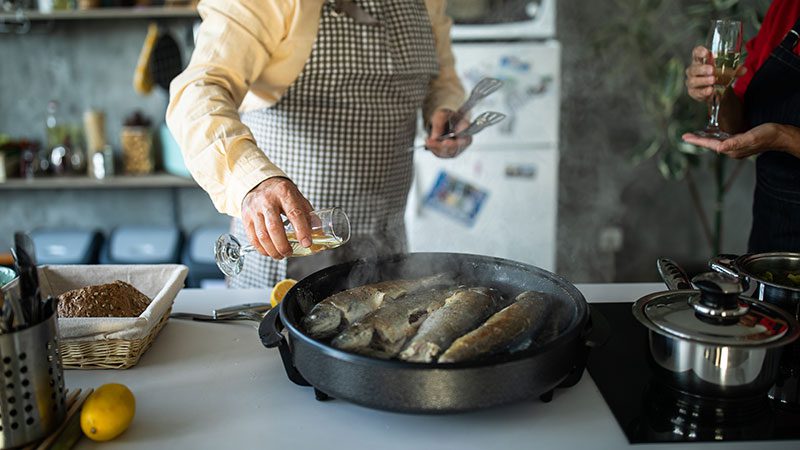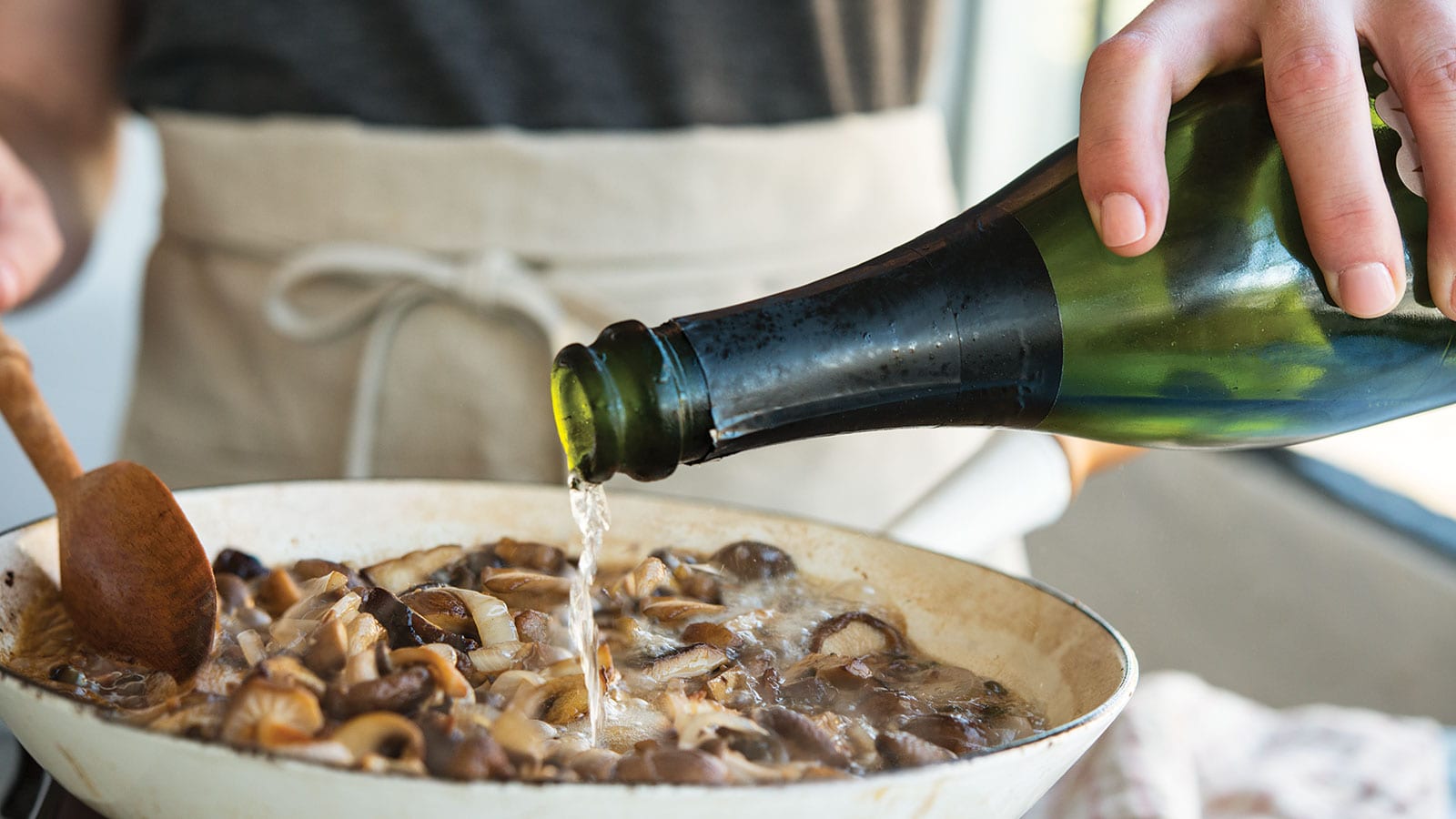The Best White Wine for Cooking

“Never cook with wine you wouldn’t drink.” Julia Child said that—or did she? The famous maxim doesn’t appear in any of her cookbooks or formal interviews, but it feels like wisdom the cooking legend would have doled out, probably while tipping half a bottle into a pot of simmering moules marinières.
Robin Leventhal, a longtime chef and former culinary director at the Wine Country Culinary Institute at Walla Walla Community College, adds a caveat for cooking with wine.
“Don’t spend $50 for a bottle of wine you’re going to cook with,” she says. “It’s not going to stand up. It’s going to change; the heat from cooking can take away a lot of complexities.”
And when cooking with white wine specifically, add a soupcon of subtlety to those basic rules.
If a recipe calls for simply “dry white wine,” it’s asking for a lift of acid, with a sidecar of depth and nuance. From there, things can go in a lot of different directions.
Guidelines on Cooking with White Wine
The first rule of cooking with white wine, says Serious Eats: Consider the sweetness. If you’re poaching pears or making a coq au vin blanc, sweetness might be part of the plan. But the majority of white wine in cooking is there to lend nuance and brightness, not sugar.
“For me it’s about, is there some bright acid?” says Leventhal. “Will it hold up?” Look for the word “dry” (aka not sweet) on the label. It’s best to steer clear of semi-dry bottles, but in a pinch, any light white wine that hasn’t been aged on oak should work just fine.
In her Wine Lover’s Kitchen cookbook, Fiona Beckett says slow-cooked dishes like stew can get away with a lower-quality wine than if you’re quickly deglazing the pan. She advocates adding “a small dash of better wine” at the end of a long braise. That’s “to make it taste as if that’s the wine you’ve cooked with.”
Best white wines for cooking
Breaking this subject down by grape is tricky. The Food Network notes that factors like winemaking style, terroir, and quality of wine matter more. Fundamentally, “all white wines have similar chemical makeups, so they will all [add] a positive impact when added while cooking.”
But no harm in being a bit reductive on this matter, especially since we’re talking about reductions. There are a few go-to varietals, and others that lend a certain charm, depending on what you’re cooking. Here’s the breakdown:
Sauvignon Blanc
The MVP of white wine thanks to that citrus profile and high acidity, capable of cutting through cream or rich sauces. In their wine-focused cooking, Cork & Knife, authors Emily and Matt Clifton write that “sauvignon blanc, when reduced, can taste almost as tart as lemon juice.” White Bordeaux, a famous French blend that includes sauvignon blanc, is another safe bet.
Pinot Grigio/Pinot Gris
Mild in flavor and high in acid, this grape is another versatile player in recipes. The acid and fruity mineral character is a good pairing with seafood, says Wine Folly, though some chefs find its delicate character gets lost in heartier or creamy dishes.
Riesling
It’s complicated. “I am a Riesling lover,” proclaims Leventhal. She champions this wine as a nice choice that hold up well in cooking. “Especially with anything fatty. If you’re making a pork chop, definitely use a Riesling.” She appreciates the stone fruit notes, the acid, and the fact that Washington has a wealth of affordable bottles. Though again, it depends on the winemaking style. If a recipe calls for a dry white wine, sweeter Riesling profiles would be a tough hang.
Chardonnay
In a video on the subject, Jack Bishop of America’s Test Kitchen suggests staying away from this one. “Those buttery, oaky notes aren’t going to work.” Simmering a wine brings out its dominant flavor, be it sweetness, tannin, or acidity, so a full-bodied, creamy chardonnay isn’t ideal for adding acid. But if you’ve got an unoaked version, it can do right by creamier dishes, like risotto.
Decoding Blends and Table Wines
Since we’re talking commercial grade, plenty of wines are simply labeled “white” or “white blend.” In these cases, scan the label. Look for recipe-friendly varieties (sauvignon blanc, pinot grigio, albariño, and the like). Avoid blends heavy on chardonnay, Riesling, viognier, or gewürztraminer. Words like “dry” and “unoaked” are a good sign. The alcohol content is another clue; anything with an ABV under 12.5% is considered light-bodied, according to VinePair.
What About Cooking Wines?
Chefs are unanimous and unequivocal: Don’t use those inexpensive bottles of cooking wine that loiter on grocery store shelves near the vinegar. Food Republic bemoans their “gnarly taste” and high levels of preservatives, including salt, to make them shelf stable.
Substitutes for Dry White Wine
Not into opening an entire bottle just to use a splash in a recipe? Cork & Knife authors Emily and Matt Clifton say dry vermouth is a handy substitute with a longer shelf life.
And if you’re trying to save money, take heed. Everyone from the New York Times to Serious Eats to America’s Test Kitchen has experimented with making recipes using cheap versus expensive bottles of wine. The verdict, per the NYT: “The wonderful wines and the awful ones produced equally tasty food, especially if the wine was cooked for more than a few minutes.”

PCC recipes: Cooking with wine
Looking for some recipe inspiration on cooking with wine? Try this collection of PCC recipes, including braised artichokes and fennel and Champagne and mustard-roasted chicken.
To learn more about what makes a great wine, and the state of the Washington wine industry, see this interview with “Wine Guy” Jeff Cox.
For a firsthand look at PCC’s wine, beer and spirits philosophy, visit any store and talk with the talented staff specialists, or sample wines at our regular store tastings.
PCC’s co-op standards for wine, beer and spirits are online here.
